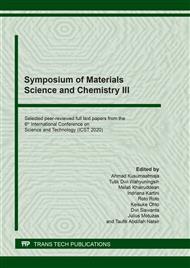[1]
I. Yang, J. Yoo, D. Kwon, D. Choi, M. S. Kim, and J. C. Jung, Improvement of a commercial activated carbon for organic electric double-layer capacitors using a consecutive doping method,, Carbon N. Y., vol. 160, p.45–53, (2020).
DOI: 10.1016/j.carbon.2020.01.024
Google Scholar
[2]
C. Dong, Z. Li, L. Zhang, G. Li, H. Yao, J. Wang, and Q. Liu, Synthesis of hollow carbon spheres from polydopamine for electric double layered capacitors application,, Diam. Relat. Mater., vol. 92, no. October 2018, p.32–40, (2019).
DOI: 10.1016/j.diamond.2018.12.011
Google Scholar
[3]
J. Zhou, L. Yiu, W. Liu, X. Zhang, W. Mu, X. Du, Z. Zhang, and Y. Deng, High performance all-solid supercapacitors based on the network of ultralong manganese dioxide/polyaniline coaxial nanowires,, Sci. Rep., vol. 5, no. October, p.1–9, (2015).
DOI: 10.1038/srep17858
Google Scholar
[4]
Y. Wang, Y. Song, and Y. Xia, Electrochemical capacitors: Mechanism, materials, systems, characterization and applications,, Chem. Soc. Rev., vol. 45, no. 21, p.5925–5950, (2016).
DOI: 10.1039/c5cs00580a
Google Scholar
[5]
Z. Q. Hao, J. P. Cao, Y. Wu, X. Y. Zhao, Q. Q. Zhuang, X. Y. Wang, and X. Y. Wei, Preparation of porous carbon sphere from waste sugar solution for electric double-layer capacitor,, J. Power Sources, vol. 361, p.249–258, (2017).
DOI: 10.1016/j.jpowsour.2017.06.086
Google Scholar
[6]
Y. Zhu, H. Hu, W. Li, and X. Zhang, Resorcinol-formaldehyde based porous carbon as an electrode material for supercapacitors,, Carbon N. Y., vol. 45, no. 1, p.160–165, (2007).
DOI: 10.1016/j.carbon.2006.07.010
Google Scholar
[7]
T. Ariyanto, B. Dyatkin, G. R. Zhang, A. Kern, Y. Gogotsi, and B. J. M. Etzold, Synthesis of carbon core-shell pore structures and their performance as supercapacitors,, Microporous Mesoporous Mater., vol. 218, p.130–136, (2015).
DOI: 10.1016/j.micromeso.2015.07.007
Google Scholar
[8]
T. Ariyanto, M. Kurniasari, W. T. Laksmana, Rochmadi, and I. Prasetyo, Pore size control of polymer-derived carbon adsorbent and its application for dye removal,, Int. J. Environ. Sci. Technol., vol. 16, no. 8, p.4631–4636, (2019).
DOI: 10.1007/s13762-018-2166-0
Google Scholar
[9]
Y. Liu, X. Liu, W. Dong, L. Zhang, Q. Kong, and W. Wang, Efficient Adsorption of Sulfamethazine onto Modified Activated Carbon : A Plausible Adsorption Mechanism,, Sci. Rep., no. September, p.1–12, (2017).
DOI: 10.1038/s41598-017-12805-6
Google Scholar
[10]
L. Stobinski, B. Lesiak, L. Kover, J. Toth, S. Biniak, G. Trykowski, and J. Judek, Multiwall carbon nanotubes purification and oxidation by nitric acid studied by the FTIR and electron spectroscopy methods,, J. Alloys Compd., vol. 501, no. 1, p.77–84, (2010).
DOI: 10.1016/j.jallcom.2010.04.032
Google Scholar
[11]
N. Wibowo, J. Setiawan, and S. Ismadji, Pengaruh Oksidator Asam Terhadap Keheterogenan Karbon Aktif,, Natl. Conf. Des. Appl. Technol. 2004, no. 2, p.190–194, (2004).
Google Scholar
[12]
A. G. Pandolfo and A. F. Hollenkamp, Carbon properties and their role in supercapacitors,, J. Power Sources, vol. 157, no. 1, p.11–27, (2006).
DOI: 10.1016/j.jpowsour.2006.02.065
Google Scholar
[13]
T. Ariyanto, R. A. G. Sarwendah, Y. M. N. Amimmal, W. T. Laksmana, and I. Prasetyo, Modifying nanoporous carbon through hydrogen peroxide oxidation for removal of metronidazole antibiotics from simulated wastewater,, Processes, vol. 7, no. 11, p.1–9, (2019).
DOI: 10.3390/pr7110835
Google Scholar
[14]
F. C. M. C. Moreno Castilla, M.V. Lopez Ramon, Changes in surface chemistry of activated carbons by wet oxidation,, vol. 38, no. 2000, p.1995–2001, (2001).
DOI: 10.1016/s0008-6223(00)00048-8
Google Scholar
[15]
M. Sandy and T. Ariyanto, Uji Performa Karbon dari Cangkang Kelapa Sawit untuk Aplikasi Electric-Double Layer Capacitors : Pengaruh Oksidasi,, (2018).
Google Scholar
[16]
P. Simon and Y. Gogotsi, Charge storage mechanism in nanoporous carbons and its consequence for electrical double layer capacitors,, Philos. Trans. R. Soc. A Math. Phys. Eng. Sci., vol. 368, no. 1923, p.3457–3467, (2010).
DOI: 10.1098/rsta.2010.0109
Google Scholar
[17]
W. Song, Y. Li, X. Guo, J. Li, X. Huang, and W. Shen, Selective surface modification of activated carbon for enhancing the catalytic performance in hydrogen peroxide production by hydroxylamine oxidation,, J. Mol. Catal. A Chem., vol. 328, no. 1–2, p.53–59, (2010).
DOI: 10.1016/j.molcata.2010.05.022
Google Scholar
[18]
D. Swantomo, C. A. L. Wijaya, and Sigit, Enhanced conductivity of supercapacitor based PAni-GO-Cellulose-Lanthanum using modification of Al current collector surface and gamma irradiation,, J. Phys. Conf. Ser., vol. 1295, no. 1, (2019).
DOI: 10.1088/1742-6596/1295/1/012077
Google Scholar
[19]
D.D. Do, Adsorption Analysis: Equilibria and Kinetics, Imperial College, London, (1998).
Google Scholar


